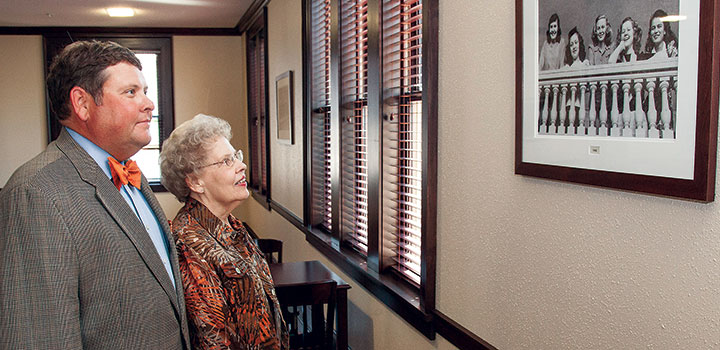
Architect Walter Altman and his mother, Jackie Codding Altman, reminisce about the history of Ashley Hall.
Valdosta State University recently restored one of its oldest buildings to its original grandeur and historical charm. First built in 1921, Ashley Hall has been a dormitory for women, student apartments, and administrative and faculty offices.
Named for former Valdosta Mayor C.R. Ashley, who served from 1900 to 1904, the 26,000-square-foot building had undergone several renovations in the past, but the recent improvements represent a complete restoration of the building.
Architect Walter Altman explains that the restoration process involved more than general improvements, replacement of faulty materials, or cosmetic upgrades to the building.
“The architect must understand not only the physical characteristics of the building but the historical significance and timeline of the original construction as well,†Altman said. “The underlying principle is to repair materials and features instead of replacing them. When the features have deteriorated beyond repair, then the replacement must have the same historical characteristics and finish.â€
Altman, who is a partner with Altman + Barrett Architects of Valdosta, first spent time researching the structure historically by reading old articles, examining original drawings, and conducting actual on-site observations, which included material testing and other investigative techniques.
“We really had to find out what was old and what was new. Developing the construction timeline is critical in determining the correct historic materials and features that need to be restored from the original building,†Altman said. “Ashley Hall has undergone several renovations over time that have either covered up or removed some of these features. We had to figure out what these features were or where these features are in order to develop the proper architectural plan and construction means and methods to produce an accurate and period correct restoration.â€
For Altman, Ashley Hall had a personal connection. His mother, Jackie Codding Altman, lived in the building while she was a student at Valdosta State College in 1965.
“I was so pleased when I heard Walter had been selected,†said Jackie Altman. “I remember the rotunda area where we had socials. It was such a formal place.â€
The rotunda, with its historical significance, was restored to its original appearance in 1921, including a skylight in the center.
“At some time the skylight was covered up during a previous renovation, and there was a chandelier added. While the chandelier did not have any significance historically, the original skylight was not only a major architectural feature, but it allowed the majority of light into the rotunda area during the daytime,†Altman said. “I found and examined the details of the original drawings and had the skylight replicated. The truncated light well and the general framing was still in place; it was simply buried under layers of more recent construction.â€
According to Robert Tucker, project manager for Allstate Construction, the rotunda area was the most labor intensive and took six weeks to complete.
“We worked with toothbrushes and small picks to get into all the crevasses and cracks. There were several layers of paint, and we carefully stripped it down to the original wood,†Tucker said. “We brought the wood back to its original look.â€
As the project progressed, Altman said they had some significant discoveries that helped identify historic architectural elements of the building. During the research and discovery process, a wall behind the staircase was removed, which revealed a closed-in space. The entombed space preserved pertinent details from the time of the original construction, including wood base molding, wood doors and window trim, flooring, and plaster all showing the actual surface texture and color.
With this discovery, Altman and the construction team were able replicate the trim and molding throughout the building.
“If we had not found the original material samples, we would have had to rely on original drawings and period photography,†Altman said. “It’s a shame, but in many instances, significant details can be lost over time without proper documentation. The first thing we did at Ashley Hall was document with drawings, photographs, video, and written description the condition of Ashley Hall. These items were submitted to the Georgia Department of Natural Resources for archiving.â€
Other finds included a fireplace in a first floor office that was covered up.
“We were able to rebuild the mantel based on the dust in the wall that left an outline of the exact profile of the fireplace. We could not find any details of the mantle on the original drawing or period photograph,†Altman said. “There was just a silhouette where it had been painted, so we were able to recreate it with the correct proportions and profile.â€

